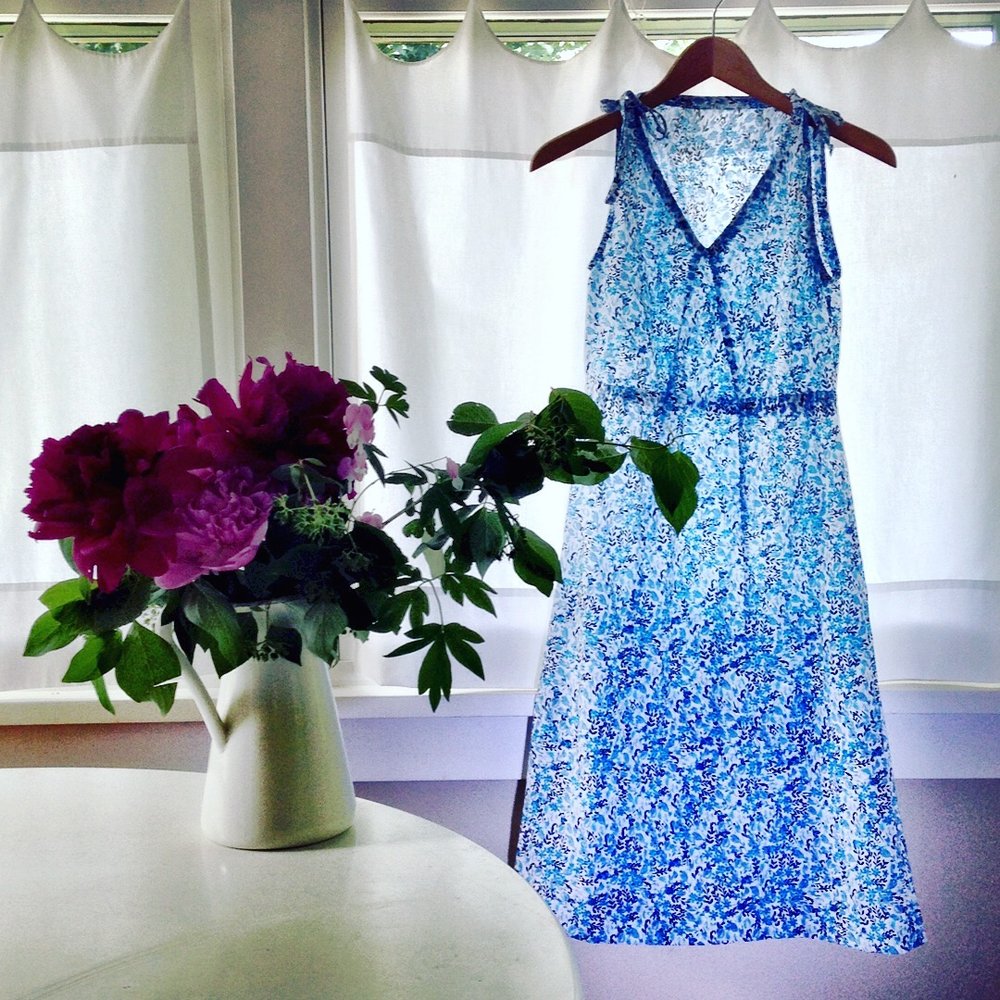I've really enjoyed exploring the world of independent pattern makers which, whether you use the PDF or printed paper versions, can open up a whole new world to the home garment sewer. I've found that, in addition to fresh and innovative designs, the independent pattern makers often provide more detail, tips/tricks and design options in their written instructions. I feel like I often learn new things from sewing along with these because of they provide a fresh perspective. One of these designers is Peggy Mead of Sew House 7. The Sew House 7 pattern that I tried was the Mississippi Avenue Dress which I made in a floral voile. It is pictured below, hanging in our kitchen-window-turned-light box, with Mrs. Porter's peonies in the foreground.

After this make, I then had an opportunity to test the Sew House 7 Nehalem pattern. I made the pants, which I love and wear constantly. I will tell you more about that pattern in a future post. Because today, I want to tell you about the Rose City Halter Dress.

Here is Lucie in the wearable toile (or muslin) of the Rose City Dress. We were both quite happy with the way it turned out. Lucie is about 5'3" and we sewed a size 8. We cut this version about 6" shorter than the printed pattern. I've tried to be more diligent about making toile to check fit and to facilitate making any changes before cutting into fabric that is one-of -kind, vintage, irreplaceable or just too precious to sacrifice to the "great unknown." It is just fabric after all, but sometimes, it is really special. On the other hand, I didn't enjoy of making up a toile out of something that is unwearable, both because it seems like such a waste to have it end up back at a thrift shop or, worse, in the landfill. In addition, it's just a more pleasant experience to work with a fabric that feels nice an behaves itself.
I've decided that using cotton gingham for a toile is a good compromise. This is the 1 inch Carolina Gingham from Robert Kaufman (available in the shop in several colors) is a good compromise. The grided pattern on Gingham has the advantage of making it easy to mark, measure and document any changes. It also comes in a wide array of great colors. I have always had a soft spot for gingham as I walks the line between sweet and sophisticated with so much aplomb! In the end, this toile turned out the be quite cute and wearable. We didn't have to make changes in terms of fit and the dry run let me work out any kinks before cutting into the Les Fleurs rayon.

I didn't find any problems at all with this pattern. I used lining fabric instead of the gingham for the undersurface of the tie (this, from a long habit of not really reading directions when using Big 4 or Japanese patterns...). This is not really a big deal, but I did make a point to do it properly in my final make. The look of this dress is quite classic, but unlike most halter dresses is really is quite "covered up in the front and on the sides. The pattern includes two skirt variations, the gathered one you see here, and a flat fronted more semi-circular shape (I haven't tried this one yet). Both variations include pockets. The pockets on his variation are wonderful, set not in the side seam, but to the front, in a way that makes the pockets much more stable and usable. This is design element that was simple to sew, and one I will definitely keep in mind when "hacking" other patterns in the future. As we all know, you've gotta have pockets.
My most frequently asked question so far is about "support." I am happy to report that this dress can be worn with a bra with convertible straps, but even with out poses little danger of "overexposure". This is a really big plus, for people who are a little more modest or full figured. It also makes the pattern very adaptable and not necessarily 'summery."


One little detail I did add to my Rose City dress was hanging loops. I inserted loops of ribbon at the top of the seam between the bodice and lining about 1 1/2 inches to the back of the side seams. These support the dress on the hanger, balancing the weight to prevent stress on the ties and help to keep it wrinkle free. Its also a fun way to use up little bits of ribbon, seam binding or tape from you stash. For this I used some vintage ribbon than cam from my grandmother.

I could easily imagine this dress as a more formal, seasonless look in a dark colored silk or even velvet. I have some dark green tartan silk in my stash that would look beautiful made up in this pattern. It would make a great Winter formal or bridesmaid dress. We may give it a try this Winter. In short, we love this pattern. I'll share the details of the final make in my next post.
Sarah



